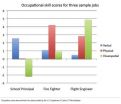(Press-News.org) We've all heard the saying about people who can't walk and chew gum at the same time, but it turns out that walking and talking is difficult enough, especially for people with Parkinson's disease who are at increased risk for falls with injury.
A new Florida State University study found that older adults with Parkinson's disease altered their gait — stride length, step velocity and the time they spent stabilizing on two feet — when asked to perform increasingly difficult verbal tasks while walking. But the real surprise was that even older adults without a neurological impairment demonstrated similar difficulties walking and talking.
A disruption in gait could place Parkinson's patients and the elderly at an increased risk of falls, according to the Florida State researchers.
Francis Eppes Professor of Communication Science and Disorders Leonard L. LaPointe and
co-authors Julie A.G. Stierwalt, associate professor in the School of Communication Science and Disorders, and Charles G. Maitland, professor of neurology in the College of Medicine, outlined their findings in "Talking while walking: Cognitive loading and injurious falls in Parkinson's disease." The study will be published in the October issue of the International Journal of Speech-Language Pathology.
"These results suggest that it might be prudent for health care professionals and caregivers to alter expectations and monitor cognitive-linguistic demands placed on these individuals while they are walking, particularly during increased risk situations such as descending stairs, in low-light conditions or avoiding obstructions," LaPointe said.
In other words, don't ask an elderly person or someone with Parkinson's to give directions or provide a thoughtful response to a complicated question while walking.
"One of the most common dual tasks performed is talking while walking," the researchers wrote. "In isolation, neither talking nor walking would be considered difficult to perform, yet when coupled, the relative ease of each task may change."
Twenty-five individuals with Parkinson's disease — six women and 19 men — participated in the study. The mean age of participants was 67.4 years. Thirteen people who matched in age and education but without a reported history of neurological impairment made up the control group.
The researchers used the GAITRite Portable Walkway System, a 14-foot mat containing 13,824 sensors that measures, interprets and records gait data as participants walk on it. After establishing a baseline, the participants were asked to walk while completing a "low load" task, counting by ones; a "mid load" task, serial subtraction of threes; and a "high load" task, continuation of an alpha numeric sequence, such as D-7, E-8, F-9, etc.
While there were no significant differences between the two groups in stride length and step velocity, members if the control group significantly increased the time they spent stabilizing on two feet from the low load to high load tasks. The researchers theorized that the control group used the "double support time" as a compensatory strategy to gain greater control of gait and balance. The Parkinson's group did not use this strategy and therefore placed themselves at greater risk for falls, they said.
Among older adults, falls are the leading cause of injury deaths, according to the Center for Disease Prevention and Control. They are also the most common cause of non-fatal-injuries and hospital admissions for trauma.
INFORMATION:
The Florida State researchers are affiliated with Tallahassee Memorial Healthcare and conducted the research at the Neurolinguistic-Neurocognitive Rehabilitation Research Center (NNRRC) at the Tallahassee Memorial Rehabilitation Center. The NNRRC is a collaboration of the Tallahassee Memorial NeuroScience Center and the Florida State University College of Medicine and the Department of Communication Science and Disorders in the College of Communication and Information.
Talking while walking puts Parkinson's patients at risk for falls
2010-09-22
ELSE PRESS RELEASES FROM THIS DATE:
Ingredient in soap points toward new drugs for infection that affects 2 billion
2010-09-22
The antibacterial ingredient in some soaps, toothpastes, odor-fighting socks, and even computer keyboards is pointing scientists toward a long-sought new treatment for a parasitic disease that affects almost two billion people. Their report on how triclosan became the guiding light for future development of drugs for toxoplasmosis appears in ACS' monthly Journal of Medicinal Chemistry.
In the study, Rima McLeod and colleagues point out that toxoplasmosis is one of the world's most common parasitic infections, affecting about one-third of the world population, including ...
NYU Langone researchers present at Transcatheter Cardiovascular Therapeutics scientific symposium
2010-09-22
Researchers from the Cardiac & Vascular Institute at NYU Langone Medical Center will present at the Transcatheter Cardiovascular Therapeutics (TCT) 2010 scientific symposium on September 21-25, 2010 in Washington, DC. They will be available for interviews during the conference.
Louis Miller, MD
Interventional Cardiology Fellow, Department of Medicine, Leon H. Charney Division of Cardiology at NYU Langone Medical Center
Wednesday, September 22, 2010
Presenter
•Very Long-term Clinical Follow-up After Fractional Flow Reserve-Guided Coronary Revascularization, ...
'Dry water' could make a big splash commercially
2010-09-22
An unusual substance known as "dry water," which resembles powdered sugar, could provide a new way to absorb and store carbon dioxide, the major greenhouse gas that contributes to global warming, scientists reported at the 240th National Meeting of the American Chemical Society. The powder shows bright promise for a number of other uses, they said. It may, for instance, be a greener, more energy-efficient way of jump-starting the chemical reactions used to make hundreds of consumer products. Dry water also could provide a safer way to store and transport potentially harmful ...
Putting on the pounds after weight loss? Hit the gym to maintain health gains
2010-09-22
COLUMBIA, Mo. – Although obesity is a major risk factor for disease, much of the threat may be associated with the metabolic (or cardiometabolic) syndrome, a cluster of risk factors related to diabetes and heart disease. Losing weight can improve health and reduce many of these risk factors. However, many people struggle to keep the weight off long-term. Now, researchers at the University of Missouri have found that people who perform resistance training while regaining weight can help maintain strides in reducing their risks for chronic disease.
"Long-term weight loss ...
Electricity collected from the air could become the newest alternative energy source
2010-09-22
Imagine devices that capture electricity from the air — much like solar cells capture sunlight — and using them to light a house or recharge an electric car. Imagine using similar panels on the rooftops of buildings to prevent lightning before it forms. Strange as it may sound, scientists already are in the early stages of developing such devices, according to a report at the 240th National Meeting of the American Chemical Society.
"Our research could pave the way for turning electricity from the atmosphere into an alternative energy source for the future," said study ...
Portable laser devices to improve disease diagnosis
2010-09-22
Portable devices that use a laser beam to probe bones, teeth, and other parts of the body for early signs of diseases like osteoporosis and tooth decay may seem like something out of science fiction. But those devices are moving closer to reality, according to an article in the current issue of Chemical & Engineering News (C&EN), ACS' weekly newsmagazine.
C&EN Senior Editor Celia Henry Arnaud notes that these new diagnostic tools will have the ability to see beneath the skin and detect disease, without exposing patients to X-rays. They embrace a technology that involves ...
For sufferers of an early-onset dementia, career choice may determine location of disease in brain
2010-09-22
Toronto, Canada – In an international study of patients with a devastating type of dementia that often strikes in middle age, researchers have found intriguing evidence that career choice may influence where the disease takes root in the brain.
The study was led by Baycrest's Rotman Research Institute in collaboration with the Memory and Aging Centre at the University of California, San Francisco and several U.S. and European clinical sites. It appears online today in the Article in Press section of the journal Neuropsychologia, ahead of publication.
Researchers ...
Study links normal function of protein, not its build up inside cells, to death of neurons
2010-09-22
A study led by St. Jude Children's Research Hospital investigators links the muscle weakness and other symptoms of a rare neurodegenerative disease to a misstep in functioning of a normal protein, rather than its build-up inside cells. The finding offers insight into the mechanism driving common nervous system disorders like Parkinson's and Alzheimer's diseases.
The work advances understanding of how the inherited mistake at the heart of spinobulbar muscular atrophy (SBMA) leads to the death of neurons in the brain and spinal cord. Investigators showed that the underlying ...
NYC public school students have high levels of access to convenience stores with unhealthy food
2010-09-22
September 22, 2010 -- Most studies of the food choices available near public schools have focused on fast food outlets rather than the full range of options available to schoolchildren. A new study by researchers at Columbia University's Mailman School of Public Health examined the patterns of exposure to a broad range of food outlets for school children in New York City.
The study, "Disparities in the Food Environments of New York City Public Schools," is published in the American Journal of Preventive Medicine Volume 39, Issue 3, and cited as the "Editor's Choice" ...
Chromium picolinate may lessen inflammation in diabetic nephropathy
2010-09-22
Bethesda, Md. (September 22, 2010) – Taking chromium picolinate may help lessen inflammation associated with diabetic nephropathy (kidney disease), say researchers at the Medical College of Georgia in Augusta. In a study comparing diabetic mice treated with chromium picolinate with those that received placebo, the researchers found that mice who received the supplement had lower levels of albuminuria (protein in the urine), an indication of kidney disease.
The Study
To arrive at their conclusions, the researchers compared three groups of mice, one lean, healthy group ...


